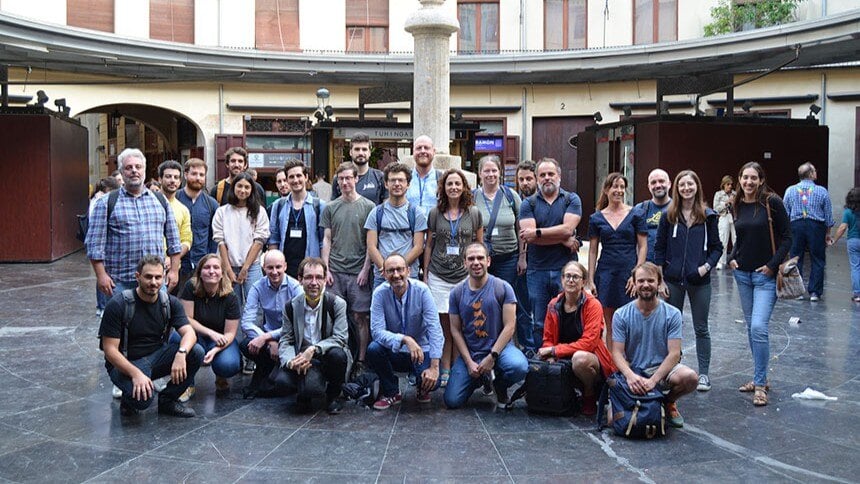An international research team co-led by staff from the Laboratory for Image Processing (LPI), the scientific-academic area of the Science Park of University of Valencia (PCUV), has just published in Nature Communications an article reviewing the use of Artificial Intelligence (AI) to deepen understanding of extreme weather phenomena-floods, droughts, forest fires and heat waves, to develop more reliable and accurate forecasting systems. The ultimate objective of the work is to contribute to improving responses to this type of disaster and bring efficiency to its communication
The devastating floods that hit Valencia last October, the forest fires that swept through Los Angeles in January, The latest unprecedented heat waves and droughts in Europe are just a few recent examples of how climate extremes become more frequent and intense, as stated by the Intergovernmental Panel on Climate Change (IPCC) of the United Nations in its latest report.
Faced with this global challenge, a study published in Nature Communications, led by the professor of the University of Valencia Gustau Camps-Valls, proposes the use of Artificial Intelligence (AI) as a key tool not only to predict but also to understand and mitigate the impact of extreme weather events on nature and people’s lives.
The article looks at how AI is advancing weather prediction systems, early detection of extreme events and impact forecasting; and is providing the opportunity to provide understandable and transparent explanations that give confidence for decision-making in the face of such climatic phenomena. "These studies show that AI is not only a tool to improve weather forecasts, but an ally to estimate their impacts, understand climate extremes and communicate risks effectively", says Camps-Valls, physicist, professor of UV electronics engineering and researcher at the Image & Signal Processing (ISP) Image Processing Laboratory (IPL).
"Thanks to AI, we not only improve the detection of extreme events, but also better understand their causes and consequences. This allows us to make more responsible and informed decisions," explains Gustau Camps-Valls, Image & Signal Processing (ISP) researcher at the Image Processing Laboratory (IPL)
The paper shows how AI has reached a certain degree of maturity in weather forecasting, extreme event detection and modelling, as well as risk communication using advanced chatbots, largely thanks to deep learning (Deep learning), statistical modelling and satellite data processing, in situ measurements and climate simulations.
The increasing frequency and intensity of these phenomena due to climate change is providing more data with which to train AI systems, which in turn improves their ability to anticipate future events and adapt their predictions to new conditions on the planet. "Thanks to AI, we not only improve the detection of extreme events, but also better understand their causes and consequences. This allows us to make more responsible and informed decisions," explains Camps-Valls.
An interdisciplinary approach to a global challenge
The study highlights that, for AI to fulfil its role in climate risk management, it is essential to overcome certain technical, ethical and operational barriers. More transparent and explainable models, greater integration of AI into early warning systems and effective risk communication are some of the key challenges.
To address these challenges, the article calls for interdisciplinary collaboration between climate scientists, AI experts, decision-makers and local actors, and ensures that only through a joint effort can accessible solutions be designed, ethical and adapted to each context. "We are laying the foundation for a technology that not only analyzes data, but can also change lives and protect our planet. However, it is essential that these tools are inclusive, ethical and accessible to all communities," concludes Camps-Valls.
Finally, the report weighs expert knowledge from both the scientific community and policy makers and vulnerable groups in order to interpret results and implement actions in the appropriate context, Ensuring the use of technology as a tool serving society and the planet.
Entitled "AI for Extreme Events Modeling and Understanding: Methodologies and Challenges", this study published in Nature Communications is the result of a workshop organized in Valencia in 2023, which brought together leaders in artificial intelligence and climate sciences within the ELLIS Program on Machine Learning for Earth and Climate Sciences.
The research team is currently working on a new dimension of early warning systems, integrating AI at all stages and which could be crucial for planning resilient infrastructure, Risk communication and long-term climate change adaptation policy formulation.
Source: UV News
Don’t miss our podcast The Livermore Bulb with IPL researcher Gustau Camps-Valls and Elena Jiménez, CEO of Helenis Biocosmetics
“AI for Extreme Events Modeling and Understanding: Methodologies and Challenges.” Gustau Camps-Valls et al. Nature Communications, 2025. DOI: 10.1038/s41467-025-56573-8
Recent Posts


